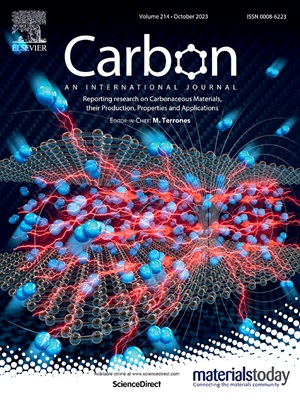Photothermal superhydrophobic coatings based on wrinkled mesoporous carbon for efficient anti-icing and deicing
IF 11.6
2区 材料科学
Q1 CHEMISTRY, PHYSICAL
引用次数: 0
Abstract
Maintaining long-term, durable icephobicity under extreme conditions such as ultralow temperatures and high humidity remains a significant challenge. In this study, a photothermal, superhydrophobic coating based on wrinkled mesoporous carbon (WMC) was developed to achieve efficient anti-icing and de-icing. The coating was fabricated by spray-coating a mixture of WMC and polydimethylsiloxane (PDMS) resin onto a PDMS-pretreated Al substrate. The resulting surface exhibited remarkable superhydrophobicity, with a water contact angle of 163° and roll-off angle of 2.8°. Under 1-sun illumination, the surface temperature rapidly increased to 76.5 °C, showcasing the superior photothermal effect. The coating effectively delayed the freezing of water droplets for up to 120 min at −15 °C, significantly outperforming conventional surfaces. The photothermal de-icing capability of the coating was assessed by monitoring the melting of frozen water droplets under simulated sunlight. The frozen droplets on the coated surface melted completely within 5 min 39 s, and the melted water easily rolled off. The outstanding anti-icing and de-icing performance of the coating is attributed to its hierarchical micro/nanostructure, which minimizes ice adhesion, and the superior photothermal efficiency of the WMC. This study highlights the potential of WMC-based photothermal, superhydrophobic coatings as highly effective and scalable solutions for anti-icing applications.

基于皱状介孔碳的光热超疏水涂层的高效防冰除冰
在超低温和高湿等极端条件下保持长期、持久的防冰性仍然是一个重大挑战。本文研究了一种基于皱褶介孔碳(WMC)的光热超疏水涂层,以实现高效的防冰除冰。通过将WMC和聚二甲基硅氧烷(PDMS)树脂的混合物喷涂到PDMS预处理的Al基体上制备涂层。所得表面具有显著的超疏水性,水接触角为163°,滚转角为2.8°。在1个太阳照射下,表面温度迅速上升到76.5℃,显示出优越的光热效果。该涂层在- 15°C下有效地延迟了水滴的冻结长达120分钟,显著优于传统表面。通过监测模拟阳光下冰冻水滴的融化情况,对涂层的光热除冰能力进行了评价。涂层表面的冷冻液滴在5 min 39 s内完全融化,融化的水很容易滚出。涂层优异的防冰和除冰性能归功于其分层的微纳米结构,最大限度地减少了冰的粘附,以及WMC优越的光热效率。这项研究强调了基于wmc的光热超疏水涂层作为高效、可扩展的防冰解决方案的潜力。
本文章由计算机程序翻译,如有差异,请以英文原文为准。
求助全文
约1分钟内获得全文
求助全文
来源期刊

Carbon
工程技术-材料科学:综合
CiteScore
20.80
自引率
7.30%
发文量
0
审稿时长
23 days
期刊介绍:
The journal Carbon is an international multidisciplinary forum for communicating scientific advances in the field of carbon materials. It reports new findings related to the formation, structure, properties, behaviors, and technological applications of carbons. Carbons are a broad class of ordered or disordered solid phases composed primarily of elemental carbon, including but not limited to carbon black, carbon fibers and filaments, carbon nanotubes, diamond and diamond-like carbon, fullerenes, glassy carbon, graphite, graphene, graphene-oxide, porous carbons, pyrolytic carbon, and other sp2 and non-sp2 hybridized carbon systems. Carbon is the companion title to the open access journal Carbon Trends. Relevant application areas for carbon materials include biology and medicine, catalysis, electronic, optoelectronic, spintronic, high-frequency, and photonic devices, energy storage and conversion systems, environmental applications and water treatment, smart materials and systems, and structural and thermal applications.
 求助内容:
求助内容: 应助结果提醒方式:
应助结果提醒方式:


